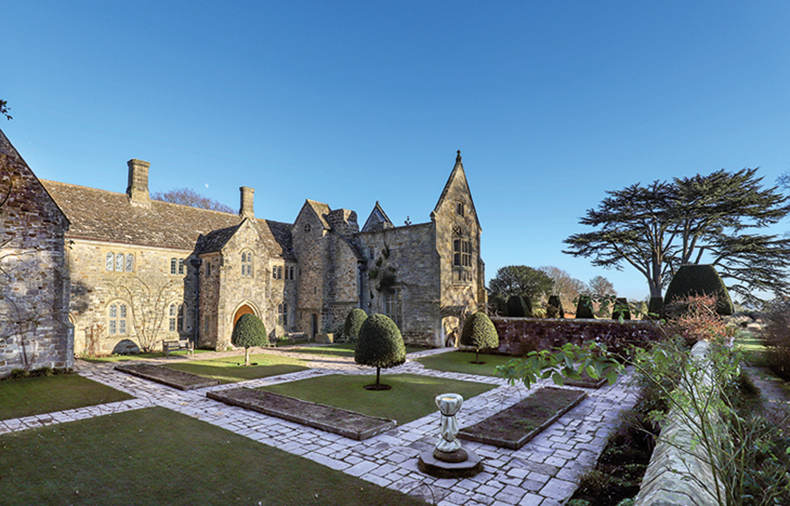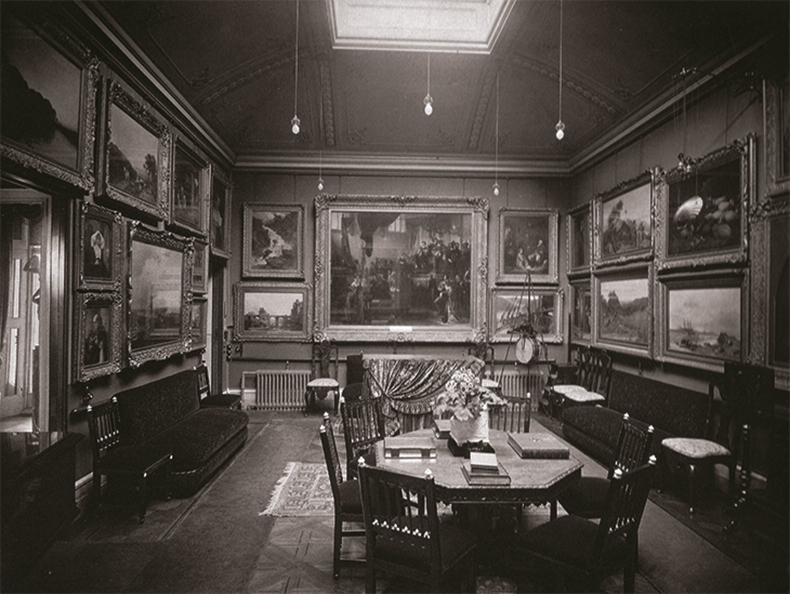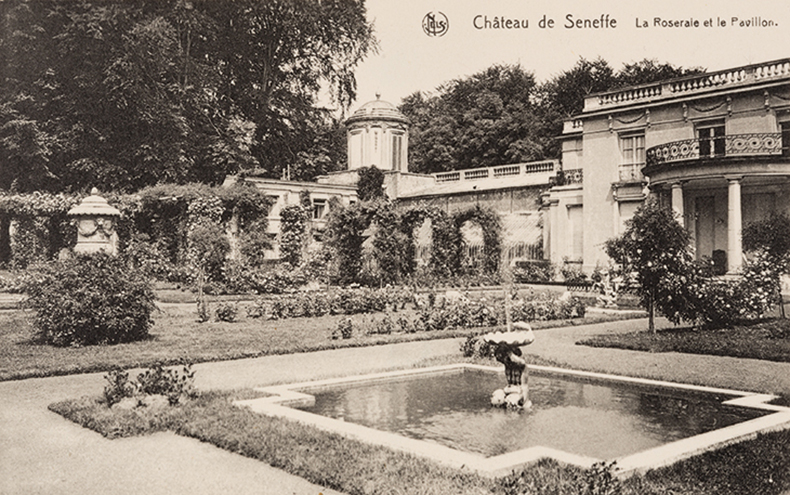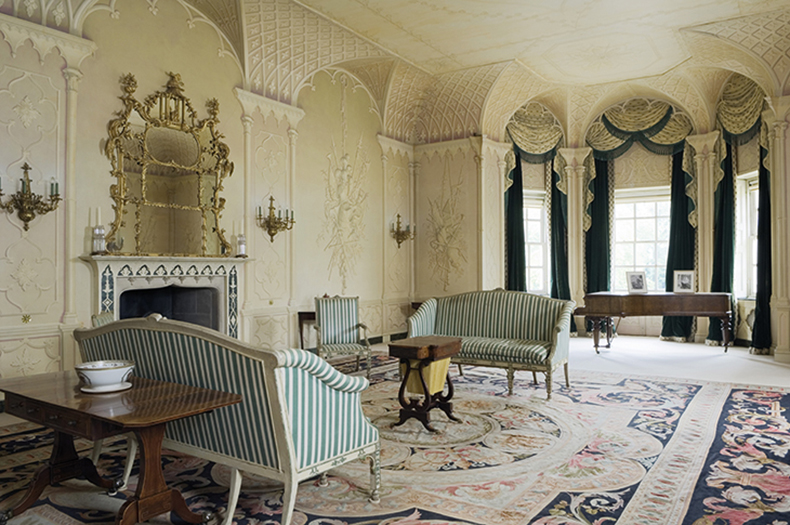From the March 2022 issue of Apollo. Preview and subscribe here.
The English country house is a powerful symbol of national identity, evoking the world of the landowning aristocracy and its feudal origins. But by the end of the 19th century, these emblems of Englishness were inhabited by a growing number of families whose fortunes owed little to inherited privilege, some of whose ancestors had been recent migrants to Britain and who until recently had suffered from legal discrimination. These families belonged to a group we might call loosely the Jewish aristocracy, who for the first time were able to buy up country seats or boldly create their own. For many alarmed commentators, the growing presence of rich Jews in the shires, no less than at court or in the House of Lords, seemed to herald a fundamental shift in the complexion of English high society. The villains in W.T. Stead’s novel The Splendid Paupers (1894) are an American doctor, Glogoul, and a Jewish manufacturer, Faulmann, who are ‘in the confidence of the whole Hebrew tribe in Europe […] whenever there is an ancient castle, or modern treasure house, or charming estate in difficulties, anywhere in the three kingdoms, they are the first to hear of it, and it is very seldom it escapes their clutches.’
Nor was this phenomenon restricted to Britain. In the decades either side of 1900 what we call Jewish country houses began popping up all over Europe, as families who had made their fortunes in finance, retail or industry claimed for themselves the pleasures, but also the responsibilities, that came with owning a landed estate. This was an unprecedented phenomenon, possible only in an era when Jews were beginning to gain full civil rights, but which has so far eluded investigation. Now, a major AHRC-funded research project, hosted at the University of Oxford and led by Professor Abigail Green, is studying British and continental examples together to think about what these houses tell us about the power and prestige, but also the vulnerability, that characterised the experience of these new elites.
If the political and social conditions for Jews varied dramatically between different states, the Jewish aristocracy itself was a cosmopolitan and interconnected group, whose marital networks, business interests, philanthropy and cultural pursuits cut across national borders. The project argues that the homes they created represent important sites of Jewish and European heritage, even if most of these houses have since been lost, forgotten or misinterpreted.
Nymans, West Sussex, bought by Ludwig Messel (1847–1915) in 1890. © National Trust Images/Chris Jonas

On first glance, there is nothing visibly different about Jewish country houses. The properties built or renovated by Jews took a huge number of different forms across Europe. Some were constructed in self-consciously vernacular or ‘national’ styles, while others, such as Waddesdon Manor, inspired by the French Renaissance, were flamboyantly dissonant from their immediate surroundings. Many were historicist in inspiration, drawing on architectural languages from past civilisations: on the Côte d’Azur Théodore Reinach worked with the Jewish architect Emmanuel Pontremoli to model Villa Kerylos on the ideal of an ancient Greek villa, albeit one in which Hellenism and Hebraism were subtly combined, with stars of David proudly set into the mosaic library floor. A few Jewish country houses, though, were radically modern, seemingly devoid of any reference to tradition. The modernist villas commissioned by the textile magnates of Brno in the Czech Republic are a case in point. Initially distorted by brutal histories of spoliation and confiscation, the elegance of Mies van der Rohe’s original design at the Villa Tugendhat can now at last be properly appreciated by tourists and architectural pilgrims alike.
The Jewishness of these places resided not in a defining ‘look’ or common style but was the result of particular human relationships. Through the acquisition of country houses, wealthy Jews asserted their right to own land and live on equal terms with their aristocratic neighbours; here, they might hold county office, dispense charity, set up schools for villagers, or maintain the local hunt. The multiplication of such houses mirrored the progress of Jewish Emancipation more broadly, namely the campaign to remove restrictions on Jewish political and civil rights, including the right to own land. This step was crucial at a time when owning land was still the passport to political influence and parliamentary representation.
Photograph of the Picture Gallery (now the Leighton Room) at Broomhill, Kent, in David Lionel Salomons’ album, c.1895. Courtesy Salomons Museum

Far from mimicking the nobility, in shaping their country piles some Jewish owners trumpeted their mercantile origins.The financier David Salomons acquired Broomhill, outside of Tunbridge Wells, in 1829, just as the campaign for Jewish political and civil rights was getting underway in Britain. Three years later, he acquired Burrswood nearby, where Decimus Burton created an Elizabethan-style country house where Salomons lived like a member of the rural gentry. In the early 1850s, he had the original Broomhill villa substantially expanded to create the house we see today. Salomons succeeded in becoming the first Jewish Lord Mayor of London in 1855 (to date the number stands at ten); four years later, he finally became an MP, having initially been barred from taking up his seat in Westminster for refusing to swear a Christian oath. His descendants ensured these hard-won achievements were preserved through a range of objects still on display at Broomhill, including the parliamentary bench which Salomons had been forbidden from sitting on, and a statue of Dick Whittington, the popular folk hero who made his fortune in the City of London. This was a country house packed with mementos of metropolitan politics, but it also contains a 16th-century Siddur, or prayer book, posters related to pogroms in Russia and even a fragment of the Western Wall. David’s brother Philip had been a pioneer collector of Judaica, creating a private museum of antique Jewish objects in the rooftop synagogue of his villa at Hove.
This cosmopolitanism of members of the Jewish aristocracy made them vulnerable in an era of deepening national rivalries. Anti-Semites often attacked these houses, and their parvenu owners, as intolerably ‘foreign’ or ‘alien’. In France in 1898, at the height of the Dreyfus Affair, the anti-Semitic newspaper La Libre Parole ran a series of columns which decried the growing number of villégiatures juifs (Jewish resorts) or châteaux d’Israël found outside of Paris. In Britain, suspicion was directed towards the financiers that partied with, and bailed out, King Edward VII (his so-called Jewish Court), or those German-born Randlords accused of exploiting South African resources, and British imperial interests, for their own profit.
These tensions can be read in the changing face of Nymans, a property now managed by the National Trust and set in the High Weald in Sussex. Its originator, Ludwig Messel, had been born into a family of affluent money-lenders (so-called Court Jews) to the Grand-Duke of Hesse, from whom they gained citizenship in reward for their services. Ludwig had moved to England, made a fortune, and married out, although his enduring support for international Jewish relief suggests. On buying the land for Nymans in 1890 Ludwig asked his brother, the renowned Berlin architect Alfred Messel, to design a country house that represented the acme of a certain kind of German taste. The result, historian John Hilary writes, resembled the villas found outside of Wannsee, or even ‘a displaced Alpine chalet’.
By his death in 1915, the Messels regretted this decision. Both the house with its striking tower and Ludwig’s German origins had begun to assume a sinister quality for locals, who accused him of spying from it. When Leonard Messel inherited Nymans, his wife Maud refused to move in unless her husband transformed the property. The result is the faux-ancient house we see today: a rambling, stone manor house, with spectacular English gardens, that has shed its Germanic associations. Yet inconspicuously embedded in the wall of the entrance courtyard, a carved stone shield depicting the star of David quietly acknowledges the family’s Jewish past.
Photograph of the Château de Seneffe in Hainaut, Belgium, in c. 1910–20 (?), when it was owned by the Philippson family. Photo: © Domaine du Château de Seneffe Archives

Unsurprisingly, there are relatively few Jewish country houses that are still open to the public in Germany. Most of these are now sites which commemorate the disasters that befell German Jewry. The persecution by the Nazis of Max Liebermann, one-time president of the Prussian Academy of Arts – culminating in the suicide of his wife and plundering of his collections – are integral to the story told at his villa in Wannsee, outside Berlin. Schloss Freienwalde in Brandenburg commemorates the neoclassical tastes and tragic career of financier and politician Walter Rathenau, assassinated by a far-right nationalist in 1922. While Rathenau’s name is preserved, many of his original things have been lost, and the house’s future is uncertain.
For a more subtle form of erasure, consider the Château de Seneffe in Belgium, built in the 18th century, but substantially restored and remodelled by Franz Philippson 100 years later. The son of a well-connected German rabbi, Philippson had emigrated to Brussels in the 1860s. A major figure in Jewish philanthropy, he was actively involved in unofficial armistice negotiations for Belgium during the last months of the Great War and worked tirelessly for the financial reconstruction of his adopted country. His family left their mark on Seneffe, too, and evocative photos record the addition of tennis courts, a swimming pool and an English garden. The rise of Nazism, however, forced Franz and his family to flee Europe and his home was confiscated by the German invaders. When the house passed to the Belgian state after the war, the decision was taken to return the house to its original, 18th-century condition; the contribution of the Philippsons was effaced.
The case of Seneffe has many parallels elsewhere in Europe where the Jewishness of such properties has been obscured. In part, this stems from what has been privileged within traditional heritage paradigms. Strawberry Hill in Twickenham remains strongly identified with Horace Walpole and the rediscovery of the gothic in the 18th century. Only very recently have other histories of the house been put in the spotlight thanks to an online exhibition curated by Silvia Davoli. That the building and some of Walpole’s collections survived at all was due to Frances, Countess Waldegrave, the daughter of the Jewish opera singer John Braham, who was a commanding political hostess in Victorian society. At the beginning of the 20th century, Strawberry Hill retained its glamour as a place for entertaining thanks to its purchase and renovation by the German-Jewish banking dynasty, the Sterns.
Rewriting the stories tied to a historic house is no easy task. Organisations set up to care for the national heritage often struggle to make sense of families whose networks defied borders. Curators and volunteers often feel unqualified to talk about what is perceived as a sensitive topic. In a time of resurgent anti-Semitism, those who care for these properties are understandably reticent about when and how they should describe the owners as Jews – and sometimes choose not to do so at all. Then there are the problems of evidence, compounded by the scattering of archives and collections. Reconstructing these lost collections, and how they were originally lived with, can restore personalities previously kept out of view.
This year Waddesdon will be bringing Alice de Rothschild out of her brother Ferdinand’s shadow, celebrating her independent contribution to the estate and its treasures (23 March–30 October). The role of women in the Jewish country house is particularly intriguing. The daughter of a German-Jewish stockbroker and collector, Maud Nelke in 1917 married Gilbert Russell. A cousin of the Duke of Bedford, he relished telling his sisters that his new bride was, ‘Not an English girl at all – a foreigner – in fact an Oriental or Jewess’ (her German parentage was an extra taboo in wartime). Despite her distance from Judaism as a religion, Maud retained a sense of being different, not least in 1938 when she flew to Germany to organise the rescue of her relatives after Kristallnacht. As she noted in her diary from Cologne that December: ‘I don’t feel any more Jewish than I did – and I never do much – but I feel a duty, an obligation laid on me, to help and to leave no stone left unturned.’
The Whistler Room at Mottisfont, Hampshire, created by Rex Whistler for Maud Russell in 1938–39. Photo: © National Trust Images/Andreas von Einsiedel

In 1934 the Russells acquired Mottisfont Abbey in Hampshire, now managed by the National Trust. Downstairs at Mottisfont the rooms are full of fine chimneypieces, Georgian furniture and British landscape art (some of it painted by Maud’s friend, Derek Hill, who donated his collection in her memory). The most striking interior is the drawing room , in which Maud commissioned Rex Whistler to produce comic murals in the manner of Strawberry Hill (‘a kind of modern Gothic,’ she specified, ‘in other words 1938 Gothic, decoration’). Here Maud showed her delight in subverting heraldic conventions: Whistler’s scheme includes books, a musical instrument, a black evening glove and a vessel inscribed with the Latin motto Magna est veritas et praevalebit (‘Great is the truth and it will prevail’), a résumé of her courageous outlook on the eve of war.
Upstairs, meanwhile, and closed to the public today, were Maud’s private apartments, which housed her collection of Post-Impressionist art, including works by Toulouse-Lautrec, Picasso, Braque and Gauguin. A patron of the Contemporary Art Society, Maud even sat for Matisse after seeing his work at the Petit Palais in 1937. Her connection to European art is still represented at Mottisfont by an angel in mosaic (bearing her likeness), executed by the Russian émigré Boris Anrep with whom she formed a romantic relationship after her husband’s death. The angel forms a counterpoint to the mosaics (known as the ‘Modern Virtues’) that she paid for Anrep to produce in the vestibule of the main hall of the National Gallery.
Mottisfont underscores that Jewish country houses were neither insular in character nor a refuge from city life. Equipped with the latest technological comforts, these houses could also be crucibles for modern politics and ideas. The collections they contained also spoke to their owners’ plural attachments. We might think of the display of early modern continental craftsmanship – including discrete pieces of Judaica – which Ferdinand de Rothschild presented to the British Museum in 1898 (the Waddesdon Bequest); or the efforts of David Salomons’ descendant Vera Salomons to preserve her family’s achievements by donating Broomhill to Kent County Council in 1937. After the war she presented some of the Bréguet clocks once housed at Broomhill to the L.A. Mayer Museum of Islamic Art in Jerusalem, an institution that she created in the 1970s to foster Arab and Jewish dialogue.
Such international connections add another dimension to houses which can otherwise appear as emphatic expressions of Englishness. Upton House in Warwickshire, the home of Walter Samuel, 2nd Viscount Bearsted, and chairman of Shell Oil, was not purely a convenient spot for hunting and weekend entertaining in the 1930s. The picture gallery installed in the former squash court – designed by Ernst Joseph, the Jewish architect of the Shell Mex building on the Embankment – revealed Bearsted’s love of Old Master pictures. The gallery formed a central part of why the National Trust rushed to accept the house after the war, with James Lees-Milne writing in his diary in 1946 that Upton contained ‘a lot of Chippendale-style furniture and Chelsea china of the very best quality. The picture collection superb, as fine as any private collection in England.’
Lord Bearsted’s love of the fine arts was informed by an ethos of public service. Not only was he a devoted trustee, chairman and donor at the National Gallery; his participation on the board of the National Arts Collections Fund (NACF) saw him actively preserve and promote forms of Jewish heritage in interwar Britain, from the Tate to the Jewish Museum in London (founded in 1932). It was from Upton that he administered the logistics of the Kindertransport, an enterprise he worked tirelessly to underwrite and promote internationally. He enlisted his art collections as part of that struggle: in May 1939 he presented a portrait by Thomas Lawrence to the Lord Baldwin fund for refugees for a charity auction at Christie’s. The catalogue for the Lord Baldwin sale shows the depth of solidarity within the wider ranks of the Anglo-Jewish elite for the persecuted Jews of Europe, as donations flowed in from families such as the Rothschilds (with Victor Rothschild contributing his most prized picture, Reynolds’ The Braddyll Family), Sassoons, Gubbays, Raphaels, Montagus and Jewish dealers on Bond Street (such as S.J. Phillips).
In 1943 Bearsted took over as chairman of trustees at Whitechapel Art Gallery, a site powerfully associated with émigré artists as well as with the local East End Jewish community. During his five-year tenure, he arranged for many of the Old Master paintings from Upton to be exhibited in Whitechapel in 1948, a remarkable event for a neighbourhood still reeling from the devastation of the Blitz.
If Upton and other houses offer us new ways of approaching questions of Englishness and integration, in their heyday they were also sites of cultural difference, not least when mobilised to serve specifically Jewish causes, as occurred across Europe in the shadow of Nazism. In 1939 James and Dorothy de Rothschild at Waddesdon Manor provided sanctuary for the Cedar Boys and Girls from Frankfurt; meanwhile, outside Hamburg, the White House in Blankenese was reclaimed after 1945 by the Warburg family and made over for the use of child Holocaust survivors. Such untold stories of activism underscore why these houses can yield up far richer insights when compared to each other and considered outside of a narrowly national framework. The splendour of the houses, like their fragility and their secrets, speaks to the ambiguous position of their owners within modern British and European society.
For details about the Jewish Country Houses project, go to https://jch.history.ox.ac.uk/home.
From the March 2022 issue of Apollo. Preview and subscribe here.


